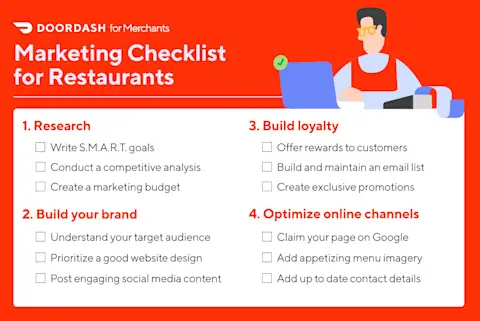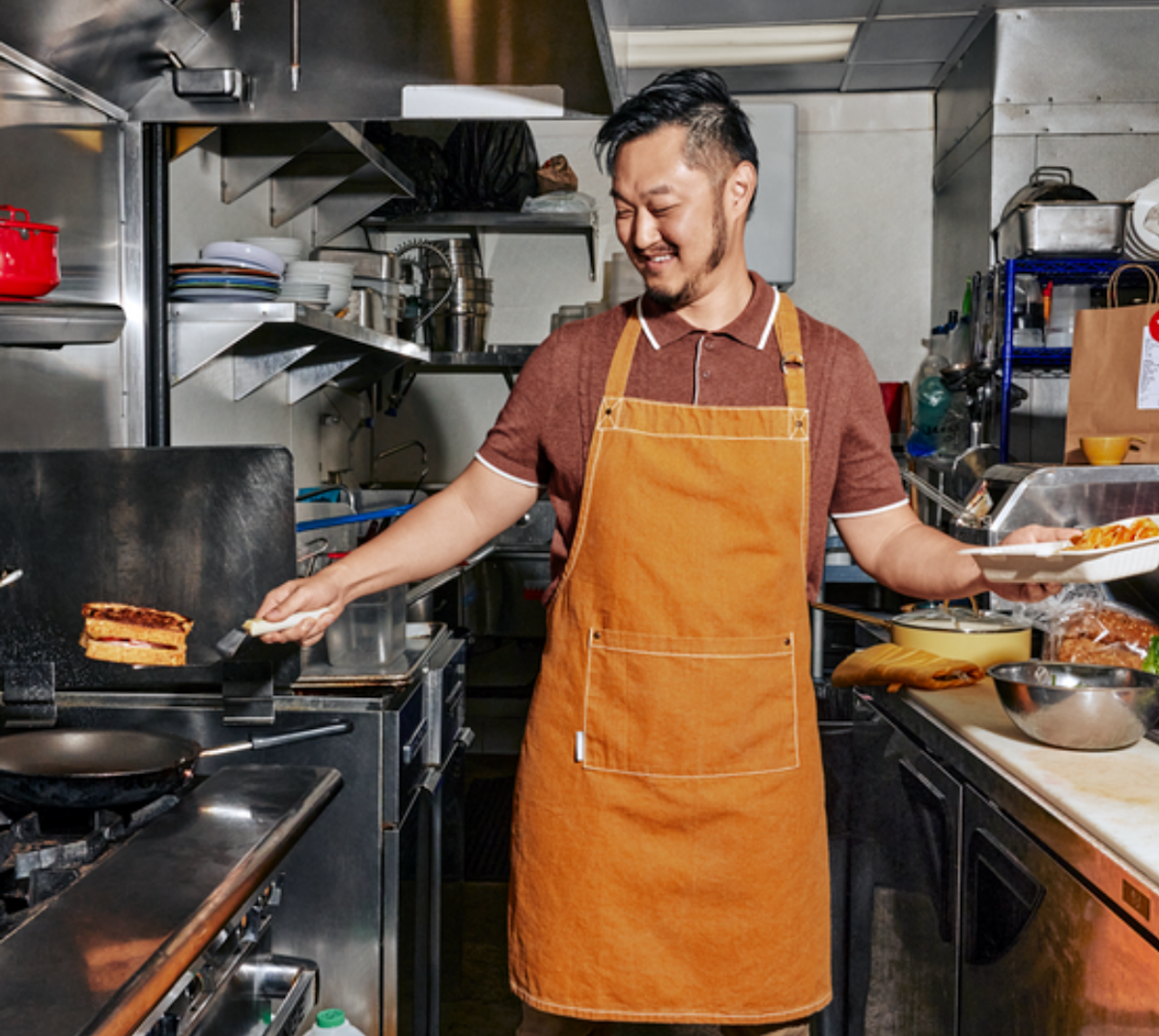In the restaurant business, it's not enough to just make great food — you also need to be a savvy marketer. Once customers love your food, they will keep coming back, but how do you get them to try you in the first place? That's where a comprehensive marketing plan comes in, and this guide, including examples of restaurant marketing plans and a useful checklist, will help you understand why you need one and how to proceed.
What is a restaurant marketing plan?
A restaurant marketing plan is a strategic roadmap detailing how your business can proactively attract new customers and retain existing ones. To plan your most effective marketing strategies, you need to begin by researching and writing about your restaurant's mission, value proposition, and unique selling points (USPs). Eventually, your marketing plan can guide you in concert with this broader restaurant business plan.

The benefits of a marketing plan for restaurants
There are multiple reasons why a robust and structured marketing plan can benefit your restaurant.
1. Be efficient
A trial-and-error approach to marketing may sometimes get results, but that unpredictability can involve a lot of misplaced effort — and that means wasted time, money, and resources. A thorough restaurant marketing plan, with a deep dive into your priorities, is a way to bring efficiency to your marketing strategies in the same way a business plan does for the operational aspects of your business.
2. Reach new customers
How can you entice curious new consumers and then convert them into loyal regulars? This is the question that should be top-of-mind for any restaurant owner, and it's precisely the question that a marketing plan can help answer. Taking time to create your plan is one of the best ways to assess which marketing channels can drive results for your business, how much you should invest in them, what success metrics you should aim for, and whether you need to alter or adjust your current promotions.
3. Gain a competitive advantage
The most compelling reason to create a restaurant marketing plan may also be the most straightforward: the hospitality industry is a saturated and competitive space, and there's little doubt that your most successful competitors are devising their own marketing plans to stay ahead. Having a strategic document that reiterates your mission and value proposition sets you up to differentiate your business, address your target audience, and stay current in a fast-paced industry.

Components of an effective restaurant marketing plan
The foundation of a restaurant marketing plan is understanding who you are as a business and what you want to accomplish.
Step 1: Be S.M.A.R.T. when setting goals
What targets does your business need to hit in order to be successful and sustainable? And how can you achieve those objectives? As you set goals, make sure they follow a S.M.A.R.T. framework:
Specific: Don't fall into the trap of making your objectives too broad or general. Narrow your focus.
Measurable: Establish how exactly you'll be able to track and benchmark any ongoing progress.
Achievable: Goals should always be realistic. If you're not pragmatic, you may be disappointed.
Relevant: Consider your overall mission for your restaurant and plan accordingly.
Time-bound: Along with being measurable and achievable, effective goals require defined deadlines.
Step 2: Conduct a detailed competitive analysis
For restaurateurs, conducting a SWOT analysis is an invaluable exercise. SWOT stands for strengths, weaknesses, opportunities, and threats, and it's a great tool for figuring out goals because it reveals where your business excels and where it struggles compared to other restaurants. To conduct a SWOT analysis for your business, consider the following:
Strengths are the internal aspects of your business that differentiate you in a positive way, like signature dishes or distinctive decor.
Weaknesses are internal factors that can negatively impact your business and hold you back, such as poor customer reviews or a lack of online presence.
Opportunities are external circumstances that you don't control but could strategically capitalize on. These can include shifting consumer preferences or social media trends.
Threats are external factors in the broader landscape that potentially pose risks. In order to decide which goals to prioritize in this first iteration of your marketing plan, you need to be ruthlessly honest about your business' problems and prospects.
But your SWOT analysis can also extend to your industry peers. Choose three to five competitors in your market that present the biggest challenge to your business, and conduct a SWOT analysis on them too. This time, how you define strengths, weaknesses, opportunities, and threats will be different. Consider these types of questions:
What are these restaurants doing well, and how could you outperform them?
What do their guests complain about, and how will you avoid these issues?
Are there ways to differentiate yourself when considering competitor weaknesses?
Based on their strengths, is there anything they do that you shouldn't compete with?
Completing your competitive analysis should help you better understand your restaurant's differentiators — and ultimately, these are the parts of your business you want to market.
Step 3: Understand your target customers
A key aspect of your brand is your ideal target customer. Marketing will be much more successful if it's honed to the particular demands, desires, and preferences of the customers who are most likely to order from your restaurant.
Relevant information to consider includes:
Demographic indicators such as age, income, and the neighborhood where they live
Psychographic traits like values and reasoning for dining out or ordering in
Behaviors such as how they engage with your business
Nearby attractions (offices, colleges, retailers, other restaurants, etc.)
This data can be collected through conducting customer surveys and interviews, reviewing your sales analytics to identify trends, and by researching demographic information via online real estate databases or industry resources like the National Restaurant Association. Look for common denominators to inform your restaurant brand personality and positioning.

Step 4: Prioritize your website
Think of your restaurant website as your second storefront — you want your customers to take notice when they see it. Just like your restaurant's physical appearance, your digital presence has the power to drive demand and increase business.
Your restaurant website should provide customers with essential information like your address and contact information, hours of operation, and menu. It should also be designed to be responsive or adaptive, meaning the layout seamlessly changes depending on the customer's device.
There are many methods you can incorporate into your marketing plan to build a high-converting, high-performing website that attracts traffic and generates engagement. Search engine optimization (SEO) involves refining keywords that customers often search for, such as the type of cuisine you specialize in and the area where you're located (e.g., "best tacos in San Diego"). Explore website optimization strategies that align with your S.M.A.R.T. goals.
But perhaps the most important purpose of a website is to serve as a hub for online orders, so your restaurant can reach all the prospective customers who want to buy what you're selling but may not want to dine in.
Step 5: Crunch the numbers and budget wisely
There is no one standard approach for planning a marketing budget. Every restaurant has its own circumstances, considerations, and objectives. If you're new to the scene, you may need to spend more on marketing to increase your brand's visibility. And while it's tempting to reduce a marketing budget when margins are small and money is tight — that's when investing in strategies to attract new customers and engage existing ones is more critical than ever.
Step 6: Optimize your online presence
You've built a website that can adeptly convert casual prospects into paying customers — but how do you convince people to visit your site in the first place?
Start by claiming your Google Business Profile and creating a Google My Business Listing. This appears as soon as people search for your restaurant online, and provides fundamental information — such as business hours, menu, photos, and reviews. Without this necessary online presence establishing your credibility and availability, curious consumers could move on to researching more enticing competitors.
Step 7: Create engaging social media content
Social media marketing is a key priority for restaurants today. Facebook supports a range of formats, from long-form text to captioned photos and videos, and also lets you pay for campaigns where you customize how much to spend, how long the ads should run, and the audience segments to reach.
Instagram and TikTok are favorites for sharing food content. While Instagram's gallery grids are a great way to show off your restaurant, your menu, your customer experience, and your company culture, short-form video is also highly effective, and this is where both Instagram and TikTok deliver value. Be intentional in how you add captions and hashtags to your content so that they're relevant to your menu, service offerings, location, and target audience.
Influencer marketing is another social media strategy that could help garner increased attention for your business. By partnering with the right influencers, you can reach a broader audience beyond traditional advertising channels.
Step 8: Cultivate customer loyalty
Repeat business is a restaurant's bread and butter, and loyalty programs are an effective way to encourage customers to return. Modern digital loyalty programs can be integrated with many point-of-sale (POS) systems. Customers are able to accrue points, which are typically determined by what they order or how much they spend.
Email marketing for restaurants needs to be handled with care — when done right, customers appreciate receiving exclusive offers, specials, or discounts from their favorite restaurants. When optimizing your website to double as an e-commerce platform for online orders and delivery, choose a provider that will let you design and deploy loyalty programs and promotions through your POS.
Step 9: Manage reviews — and your reputation
Just as you claimed your Google My Business page, you'll also want to claim your page on the main restaurant review sites, where more and more customers are doing their preliminary research.
In many ways, these sites function as additional advertising and help to further boost your business' online presence. Make sure you add appetizing photos and maintain current contact and location information. Then respond to reviews to demonstrate that your restaurant cares about its guests.
Whether a review is positive or negative, it warrants a reply.
Positive reviews: Express your sincere appreciation — you might earn a repeat customer.
Negative reviews: Remain respectful to show you care about the customer's experience. Consider offering them a discount to return, or explain steps you've taken to address the issue in their comment.
A restaurant marketing plan matters for success
An effective restaurant marketing plan takes work, but it means your business is engaging customers all day, every day — even when your store isn't open. Your performance on search engines, your presence on social media platforms and review sites, and any online advertising campaigns are all working 24/7 to build visibility for your brand. Take everything you learned from your SWOT analysis, market research, and customer research, and determine actionable steps for accomplishing your specific, measurable, achievable, relevant, and time-bound goals.
Once you've determined your objectives and the results you want to attain, the next step is to implement the strategic initiatives to hit your targets. The Social Media Holiday Calendar for Restaurants is an invaluable resource for making this happen, with tools, tips, and templates to streamline the planning process.



